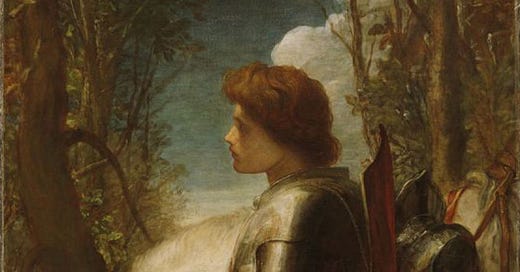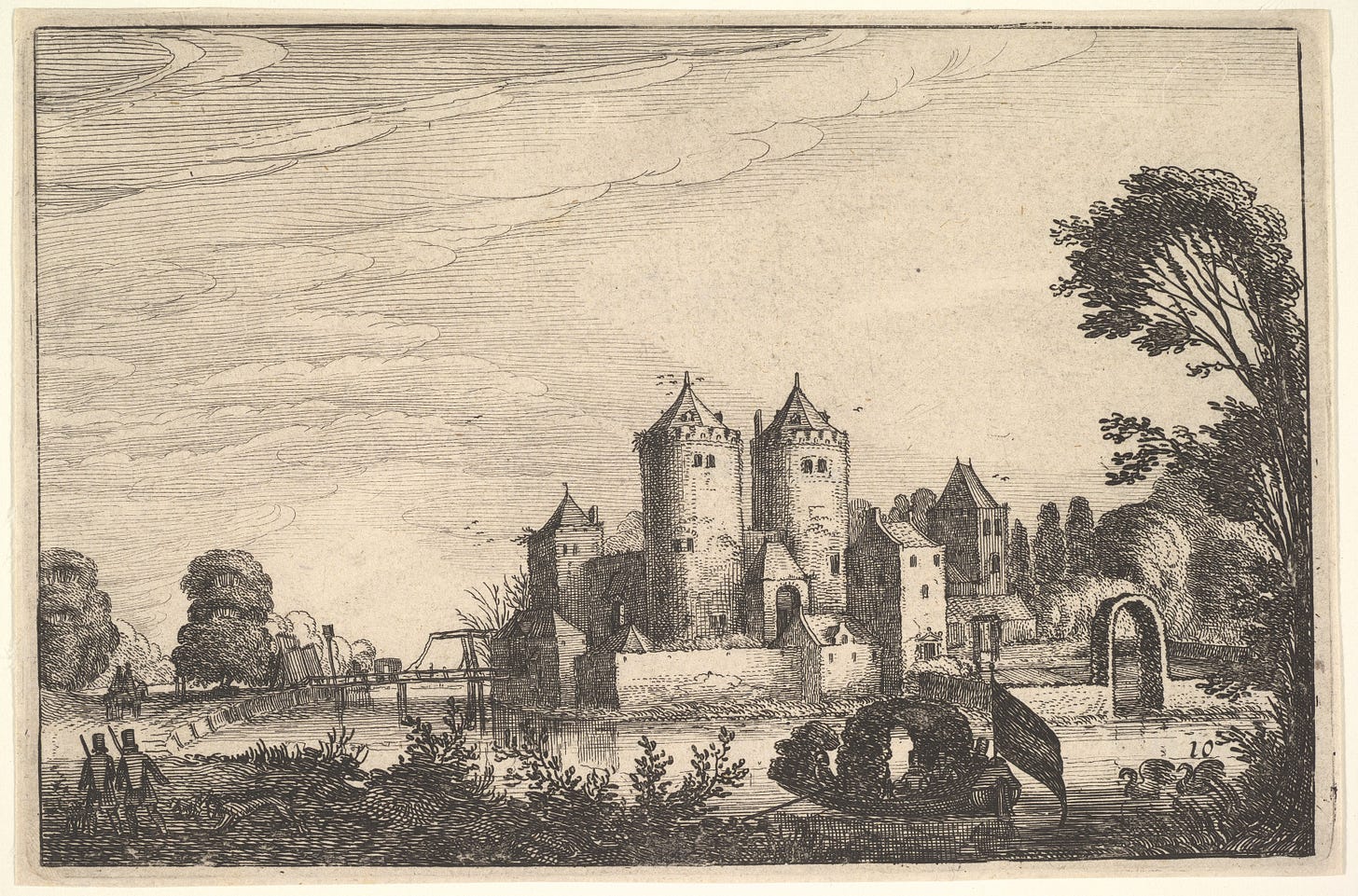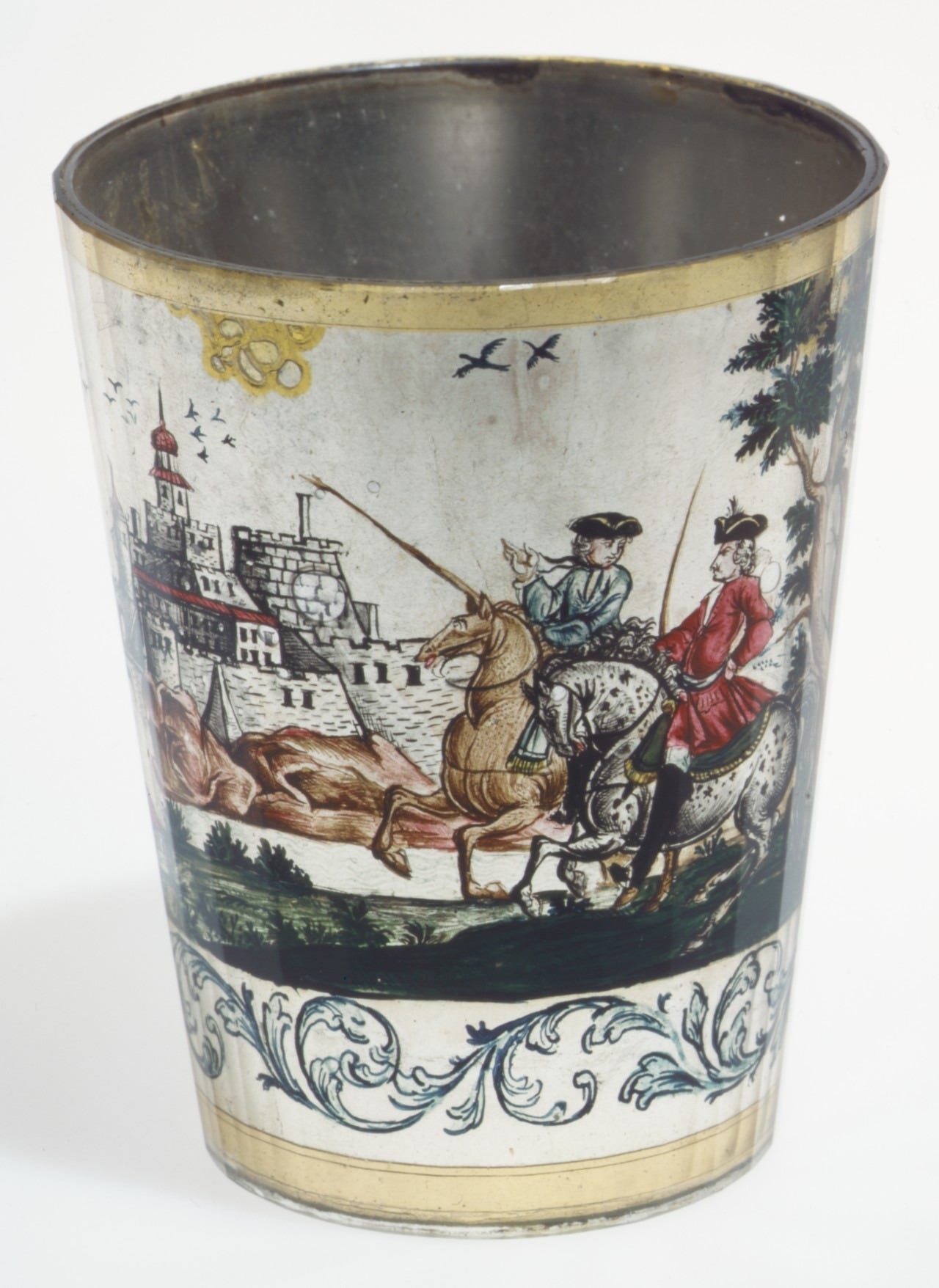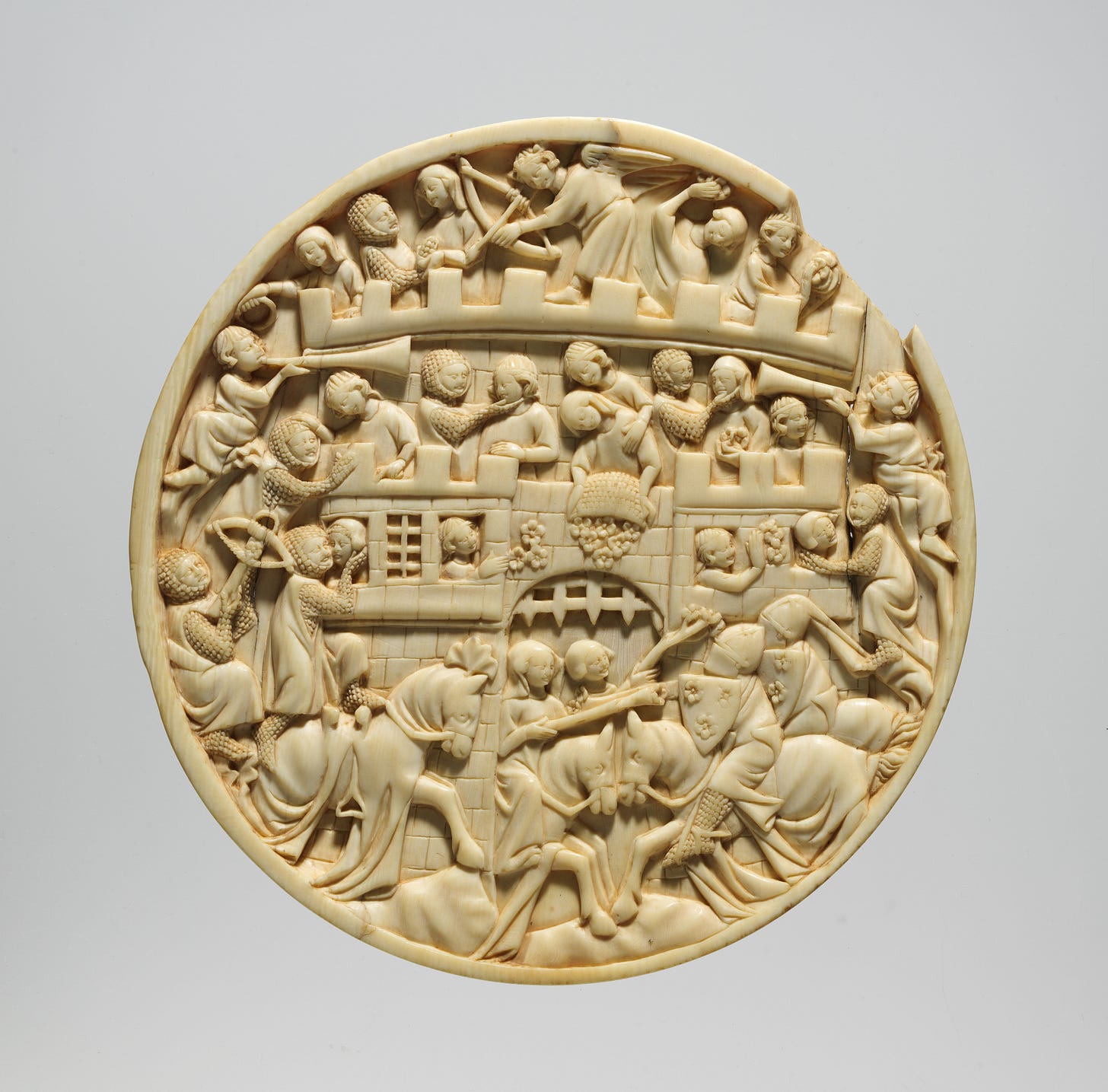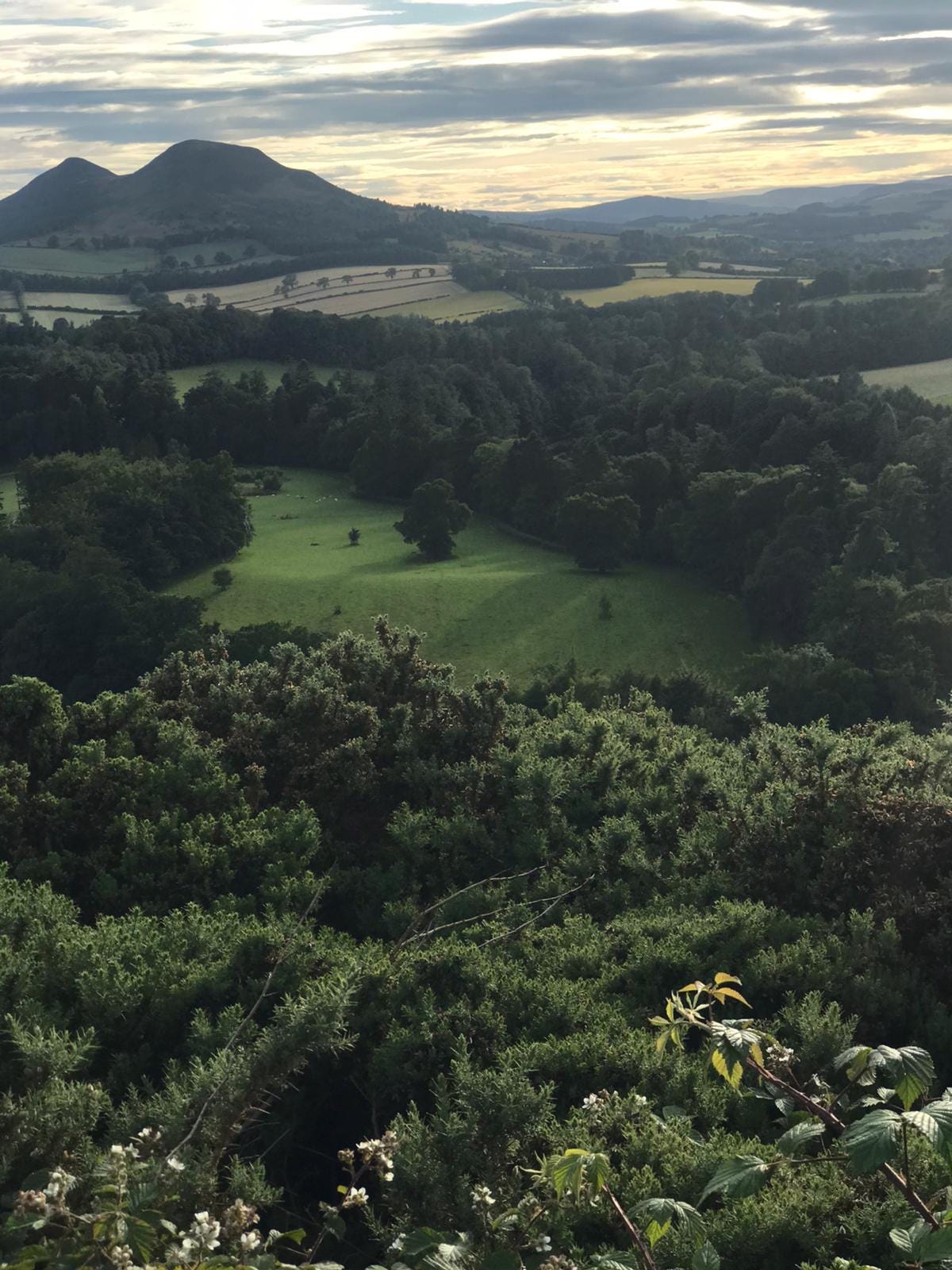"Lochinvar" by Sir Walter Scott
Narrative poetry is especially accessible to children--here is one full of adventure, true love, and dash!
Sir Galahad by Sir George Frederick Watts, 1860-62, Fogg Museum, Harvard Art Museums, USA.
Lochinvar
By Sir Walter Scott
O young Lochinvar is come out of the west,
Through all the wide Border his steed was the best;
And save his good broadsword he weapons had none,
He rode all unarm’d, and he rode all alone.
So faithful in love, and so dauntless in war,
There never was knight like the young Lochinvar.
He staid not for brake, and he stopp’d not for stone,
He swam the Eske river where ford there was none;
But ere he alighted at Netherby gate,
The bride had consented, the gallant came late:
For a laggard in love, and a dastard in war,
Was to wed the fair Ellen of brave Lochinvar.
So boldly he enter’d the Netherby Hall,
Among bride’s-men, and kinsmen, and brothers and all:
Then spoke the bride’s father, his hand on his sword,
(For the poor craven bridegroom said never a word,)
“O come ye in peace here, or come ye in war,
Or to dance at our bridal, young Lord Lochinvar?”
“I long woo’d your daughter, my suit you denied;—
Love swells like the Solway, but ebbs like its tide—
And now I am come, with this lost love of mine,
To lead but one measure, drink one cup of wine.
There are maidens in Scotland more lovely by far,
That would gladly be bride to the young Lochinvar.”
The bride kiss’d the goblet: the knight took it up,
He quaff’d off the wine, and he threw down the cup.
She look’d down to blush, and she look’d up to sigh,
With a smile on her lips and a tear in her eye.
He took her soft hand, ere her mother could bar,—
“Now tread we a measure!” said young Lochinvar.
So stately his form, and so lovely her face,
That never a hall such a galliard did grace;
While her mother did fret, and her father did fume,
And the bridegroom stood dangling his bonnet and plume;
And the bride-maidens whisper’d, “’twere better by far
To have match’d our fair cousin with young Lochinvar.”
One touch to her hand, and one word in her ear,
When they reach’d the hall-door, and the charger stood near;
So light to the croupe the fair lady he swung,
So light to the saddle before her he sprung!
“She is won! we are gone, over bank, bush, and scaur;
They’ll have fleet steeds that follow,” quoth young Lochinvar.
There was mounting ’mong Graemes of the Netherby clan;
Forsters, Fenwicks, and Musgraves, they rode and they ran:
There was racing and chasing on Cannobie Lee,
But the lost bride of Netherby ne’er did they see.
So daring in love, and so dauntless in war,
Have ye e’er heard of gallant like young Lochinvar? The Castle by Jan van de Velde II, Dutch, ca 1616, Metropolitan Museum of Art, USA.
*****Special thanks to for his help with meter scansion and insight!*****
Let’s Dive In!
We always begin our engagement with poetry with the literal: “What is happening in this poem?” Today, the answer to that question is an exciting story of gallant deeds and true love! Read the poem twice, then try to narrate the basic plot of the story in plain prose. Teachers, lead the narration with as much or as little aid as your students need. You can take turns narrating, or each student can offer his or her own interpretation. Refer to the poem as much as you like. Once everyone (who wishes to) has had a turn, you as teacher should bring it all together with a summary—your own, or the one I offer here.
Lochinvar is a knight par excellence—a knight who is the best of the best: “So faithful in love and so dauntless in war, / There never was knight like the young Lochinvar” (lines 5-6). Lochinvar is the best knight and he has the best horse: “Through all the wide Border his steed was the best” (2). He rides with speed and skill until he reaches his destination, the castle of Netherby where his lady-love, Ellen, lives. Though he comes with speed, however, he is too late, for Ellen has consented to marry another man, a man who seems to be a slug when compared to our hero, Lochinvar: “For a laggard in love, and a dastard in war / Was to wed the fair Ellen of brave Lochinvar” (11-12).
Lochinvar “boldly” (13) strides into the castle hall in the middle of the wedding feast. Ellen’s father is alarmed to see the former suitor of his daughter and demands if Lochinvar comes “in peace here, or come ye in war” (17). Lochinvar reminds Ellen’s father that he had refused to consent to his marriage with Ellen, and so he is here for one cup of wine and one dance with the bride. He boasts that Scotland is full of beautiful maidens who would gladly marry him: “‘There are maidens in Scotland more lovely by far, / That would gladly be bride to the young Lochinvar’” (23-4).
Ellen kisses a goblet of wine and passes it to Lochinvar. She smiles at him, he takes her hand, and the two dance across the banqueting hall. The sight of the pair is so lovely that Ellen’s lady friends whisper to each other, “‘Twere better by far / To have matched our fair cousin with young Lochinvar’” (35-6). Amidst this admiration and the fretting and fuming of Ellen’s mother and father, the couple reach the end of the hall where the door stands. Lochinvar suddenly lifts Ellen onto his horse, jumps into the saddle in front of her, and away they dash! Lochinvar cries, “‘She is won! we are gone’” (41), and all the running, riding, and chasing of Ellen’s family cannot find “the lost bride of Netherby” (46). The poem’s final couplet praises again the virtues of Lochinvar, leaving us with no doubt of the young couple’s living happily ever after: “So daring in love and so dauntless in war, / Have ye e’er heard of gallant like young Lochinvar?” (47-8).
Horseman with Castle vista, Bohemia,, ca 1730, Metropolitan Museum of Art, USA.
For Your Young Children…
A narrative poem like this is rich food for the imagination! If your children are already interested in knights, dragons, castles, damsels, and warring factions, the content of “Lochinvar” will fit in nicely with their existing mental landscape. If medieval ‘romance’ (meaning adventure, chivalry, knights errant, etc, not romantic love as portrayed by contemporary Valentine’s Day marketing) is new to your crew, you will find a list of my family’s favourite castle books in the final section of this document, titled, Additional Resources. The list is not exhaustive; town libraries are usually well-stocked with material in this genre.
If you have little ones who can play Snakes and Ladders, around age three and older, I would make this poem into a simple board game to play together. You need a piece of paper, a die, and a player piece for everyone (buttons, beads, Monopoly pieces, noodles, whatever). Here is a pdf attachment of a “Lochinvar” game I made with the help of my children, but you can easily make you own!
A Closer Look at the Poet’s Words…
The first stanza of our poem today drops us squarely in the atmosphere of adventure and chivalry. Sir Walter Scott considered the days of knights and castles to be a high point in history, resplendent with beautiful gems of daring deeds and elevated ideals. He was asked to write a paper on chivalry, and you can read his thoughts on the subject on the Brittanica website. Here is a quote, in which he reflects how the code of chivalry, albeit lived out imperfectly, was nevertheless the inspiration in back of much good in society:
The [chivalric] system, as we have seen, had its peculiar advantages during the middle ages [sic]. Its duties were not, and indeed could not always be performed in perfection, but they had a strong influence on public opinion; and we cannot doubt that its institutions, virtuous as they were in principle, and honourable and generous in their ends, must have done much good and prevented much evil. We can now only look back on it as a beautiful and fantastic piece of frostwork, which has dissolved in the beams of the sun! (emphasis mine)1
Sir Walter Scott explores the age of chivalry in such novels as Ivanhoe (1820) and such long poems as Marmion (1808). “Lochinvar” was not published on its own, but was imbedded in Marmion, a dramatic tale set during the tumultuous years of the early 16th Century and culminating in the Battle of Flodden in 1513. During the late Middle Ages (and not only then), Scotland and England fiercely and frequently disputed the Scottish Borderlands. Netherby Hall, the home of fair Ellen, is in the liminal space called the “Border” (2), the “Scottish Borderlands”, or, even, the “Debateable Land”. It should immediately stand out to the reader that Lochinvar, who is a paradigm of knightly virtue, is Scottish. His name contains the Scottish word ‘loch’, meaning lake, and if you look at a map of the Scottish Borderlands, you can see to the west of that region is the southern part of Scotland. The poem’s first line, then, should clearly identify our hero as a Scot: “O, young Lochinvar is come out of the west” (1).
In true ballad style, “Lochinvar” compresses its storyline within just eight six-line stanzas. The meter, technically called anapestic tetrameter, carries us along with our hero, from “out of the west” (1), to the confrontation of foes in Netherby Hall, to the escape of the lovers “over bank, bush, and scaur” (41). Anapestic tetrameter mimics the galloping of a horse’s hooves, a wonderfully effective method of drawing the reader alongside the titular hero, Lochinvar. The rhyme scheme is a trio of couplets, aabbcc, varying the first two rhyming couplets in each stanza, but ending the last one with “Lochinvar”. Thus, each stanza ends with the same rhyme, cc: “war” in the first three stanzas, “far”, “bar”, “far” again, “scaur”, and “war” again in the final rhyming couplet, all paired with the name of our hero: Lochinvar. This repeated rhyme scheme adds a balladic sing-song quality to the poem.
Besides the end rhymes, the poem contains an amazing array of assonance and alliteration, as, for example, in the first couplet of the sixth stanza:
So stately his form, and so lovely her face, That never a hall such a galliard did grace;
Notice the mirroring of words in line 30: “So stately” – “so lovely”, “his form” – “her face”, which works to emphasize the image of Lochinvar and Ellen facing each other in the dance, matched in complementarity. And, as if that were not enough, the next line uses the <a> sound, which framed line 31 with “stately” and “face”, to embody the “grace” of the “galliard” (a popular Renaissance dance) being described; this line is packed with assonance: “That never a hall such a galliard did grace” (32, emphasis mine). Say it aloud—it is as smooth as butter. The next couplet is full of the harsher literary device, alliteration, repeating consonant sounds instead of vowels. Using the same mirroring to pair Ellen’s parents, Scott writes, “While her mother did fret, and her father did fume” (33). The effect of the repeated <f> sound is not one of graceful complementarity, but of fractious restlessness. Next, the man who has ostensibly usurped Lochinvar as Ellen’s betrothed receives contemptuous mention: “And the bridegroom stood dangling his bonnet and plume” (34). Again, Scott uses alliteration in this line, but with only two consonant repetitions in “bridegroom” and “bonnet”, both of which fall on the stressed syllables of their anapestic foot. While the meter is not varied here, it seems to dawdle a little, much like the cowardly groom, who is clearly unwilling to pick a fight with the virulent Scotsman who is dancing his bride across the hall. The reader can have no objection to Ellen’s bride’s maids’ statement that closes the stanza: “‘’Twere better by far / To have matched our fair cousin with young Lochinvar’” (35-6).
The penultimate stanza speeds up again with a spondee at the beginning of the first line: “One′ touch′ to her hand, and one word in her ear” (37). The meter compression, a spondee instead of an anapest, adds to the sense of urgency and expectation as Lochinvar and Ellen reach the end of the hall. Research on the galliard indicates that the dance, which involves a lot of fancy footwork, can be embellished with a volta, or lavolta, in which the man lifts the lady and turns her 270 degrees. The reader can imagine this is exactly what Lochinvar does with Ellen as he volts her onto the saddle of his good steed: “So light to the croupe the fair lady he swung, / So light to the saddle before her he sprung!” (38-9). The cry of triumph that Lochinvar gives next rises above the shocked surprise of all Ellen’s kinsmen: “She is won! we are gone” (41). Notice the monosyllabic words and the rhyming of “won” and “gone”. The stress of the anapestic foot falls on the two rhyming words, adding to the power of Lochinvar’s shout.
The final stanza describes the chase that vainly follows the “lost bride of Netherby” (46). Lochinvar crosses “Cannobie Lee” (45), thereby bringing his lady safely to Scotland where, presumably, the couple live happily ever after. The poem’s final couplet repeats Lochinvar’s panegyric from the final couplet of the first stanza: “So daring in love, and so dauntless in war, / Have ye e’er heard of gallant like young Lochinvar?” (47-8).
Roundel with Scenes of the Attack on the Castle of Love, French, ca 1320-40, The Cloisters at the Metropolitan Museum of Art, USA.
Biography and History: Sir Walter Scott, 1771-1832, Scottish
Sir Walter Scott was born in Edinburgh on August 15th in 1771. The year 1771 is five years before the United States of America declared their independence from Britain, and eighteen years before the French Revolution began with the storming of the Bastille. Sir Walter Scott stands squarely within the Romantic Age, a literary period that was in reaction to the violence and social upheaval both in American and in France. In addition to those two revolutions, Scott was also influenced by the stories of Scottish rebellion against England. During the years he lived with his grandparents on their farm in the Scottish Borderlands, he imbibed all the drama and folklore of the Jacobite rebellion of 1745, an event still very much alive in the memories of the older generations of the Borderlands.
Though born in the city, Scott lived with his grandparents and aunt as a very young child. In 1775, he was well enough to return to Edinburgh and begin schooling. Again in 1783, during his early teens, he lived away from home, this time with aunt ‘Jenny’ in the border town of Kelso. Aunt Jenny’s poetry and ballad recitations, along with Grandma Barbara’s stories of the border raids between the English and Scots, set deep roots in Scott’s imagination. These tales heard in childhood would grow into a literary legacy of enormous merit.
Sir William Scott’s poetry and novels were all published anonymously through a publishing house owned by James Ballantyne, a life-long friend whom he met during his stay with his aunt ‘Jenny’ and with whom he shared his love of literature. His ‘real job’ was in the field of law, being appointed Sheriff (local judge) of Selkirkshire in 1799 and clerk of session in Edinburgh in 1806. He married Charlotte Charpentier in 1797; though the couple knew each other for a mere three weeks before they wed, they enjoyed thirty happy years of marriage. They had four children, the descendants of whom today live all over the world.
Sir Walter Scott was a poet before he was a novelist. His first works were translations of German ballads. In 1802 and 1803 he published Minstrelsy of the Scottish Border with the intention of preserving Scotland’s oral tradition of song and poetry that was already fast fading from popular memory. He wrote three long poems, The Lay of the Last Minstrel (1805), Marmion (1808), and The Lady of the Lake (1810). After declining the honours of Poet Laureate in 1813, Scott turned to novels, beginning with Waverley in 1814, which told the story of fictional characters during the time of the Jacobite rebellion of 1745, about which Scott had heard so many stories from his grandparents. Waverley was the first historical novel to be written; it was so well received that Scott followed it with several sequels. He continued to write poetry, interspersed within the novels, a famous example of which is “Proud Maisie”.
Sir Walter Scott’s genius allowed him to present the tension between the old order and the new. In his poetry and novels, the old ways are not cast aside ungratefully, but are given honour and a memorial, while the new order is not obstructed, but accepted and adopted, thereby bringing about peace and hope of a better future. He is both nostalgic and practical, romantic and politic. He remains one of the most influential writers of the Romantic Age, a brilliant poet, and father of historical fiction.
Sir Walter Scott’s favourite view of the Scottish Border, where the River Tweed meets the Eildon Hills
Sir Walter Scott would always stop at this spot to admire the view--his favourite view of the Scottish Borders, where the River Tweed meets the Eildon Hills. His horses, without being directed, would always pause here, from habit. Scott's funeral procession included this view in the route they took to the place of burial.
Tools and Vocabulary for Poem Analysis
Ballad: A traditional form of poetry, usually sung, passed down orally between generations, often containing a refrain.
Assonance: Repetition of the same or similar vowel sounds within a line of poetry, eg, “With silkin lines and silver hooks” (from “The Bait” by John Donne).
Anapest: Metrical foot consisting of two unstressed syllables followed by a stressed. And example of a single word in anapestic meter is in˘-ter˘-cede′, and a phrase is it˘ is˘ well′.
Tetrameter: Describes the length of a line of poetry that has four metrical feet.
Anapestic Tetrameter: The meter of “Lochinvar”, consists of four anapestic feet per line, which means each line gets four stressed syllables. This meter seems to mimic galloping hooves, which many poets use to good effect: Byron in “The Destruction of Sennacherib”, Clement Moore in “’Twas the Night Before Christmas”, and Scott in “Lochinvar”.
Brake: As seen in line seven of “Lochinvar”, ‘brake’ in Scottish dialect refers to a clump of bushes or briers.
Galliard: Popular dance from the Renaissance consisting of complex footwork and optional flourishes such as the volta, in which the man lifts the lady and turns her 270 degrees.
Scottish Borderlands: This is the territory along Scotland’s southern border and England’s northern border. During times of conflict between Scotland and England, the Borderlands were the locale of most military action.
Edinburgh: The capitol city and main metropolis of Scotland. At the time Sir Walter Scott was born, the Old City of Edinburgh had poor sanitation and air circulation, causing the spread of much disease. When Scott returned to his family at the age of five, after living with his grandparents in the Borderlands for three years, his family had moved to a larger house in the New Town.
Jacobite Rebellion of 1745: This was the final attempt of several to restore the British monarchy to the family of Stuart, which reached back to King James VI of Scotland, who became King James I of England after Elizabeth I died in 1603. ‘Bonny Prince Charlie’, great of legend and song, led the Scots against the English in 1744-1745, but was eventually defeated and fled to France. Though Charles James Stuart was in the direct line of succession, the Act of Settlement passed in 1701 debarred Catholics from ruling, and so the crown passed to a staunchly Protestant, more distant relative of Queen Anne (Charles’ half-aunt), and the House of Hanover was established. Sir Walter Scott’s grandparents told him first-hand stories of the Jacobite rebellion of 1745.
Romantic Age: (1785-1830) A literary period that saw a return to a more natural and spontaneous expression of poetic vision, in reaction to the formalism of the eighteenth century.
Further Up and Further In
Sir Walter Scott was revolutionary, and, consequently, famous, for using real place names in his poetry and novels. Go through this poem and underline or highlight the proper nouns (people and places with specific names that are capitalized). If you like geography, pull out a map of Scotland, and see if you can locate the action of the poem. If you are interested in Scottish clans and their history, look up the surnames mentioned in the poem’s final stanza, and learn about their stories, mottos, and coats of arms. If you were writing a story, would you use real names of rivers, mountains, countries, and people, or would you invent fictional names? Why?
Sir Walter Scott is considered the father of historical fiction. Choose a period of history and make it the setting of a poem, a letter, or a story.
Additional Resources
Sir Walter Scott famously built a huge and wonderful estate called Abbotsford. You can visit Abbotsford to this day.
You can also visit Netherby Hall of (Lochinvar’s lady love, Ellen Græme). It has a rich and exciting history going back two millennia. Today it is run as a hotel, and one of the suites for hire is called “Sir Walter Scott”.
List of our favourite medieval era books:
1. Toddlers and Preschoolers:
§ See Inside Castles, an Usborne Flap Book by Katie Daynes
§ The Ink Garden of Brother Theophane by C M Millen
§ A Medieval Feast by Aliki
§ The Knight and the Dragon by Tomie dePaola
§ Any Usborne board book—so many and so good!
2. Preschoolers through Primary Grades
§ Saint George and the Dragon by Margaret Hodges
§ The Kitchen Knight by Margaret Hodges
§ Days of the Knights by Christopher Maynard, a DK Reader, Level 4
§ Joan of Arc by Diane Stanley
§ Great Medieval Projects You can Build Yourself by Kirs Bordessa
§ Castle by David Macauley
§ Eyewitness Books, Knight and Castle
§ A Year in a Castle by Rachel Coombs
§ It’s Fun to Draw Knights and Castles by Mark Bergin
3. Age Eight and Beyond, chapter books for read-aloud or independent reading…
§ The Door in the Wall by Marguerite de Angeli
§ Adam of the Road by Elizabeth Janet Gray
§ The Canterbury Tales retold by Geraldine McCaughrean
§ The Adventures of Robin Hood and King Arthur and His Knights of the Round Table by Roger Lancelyn Green (There are many classic re-tellings of these tales, but Green’s are our favourites.)
§ The Island of the Mighty by Padraic Colum (more advanced; Colum may sacrifice clarity for poetic expression.)
§ Castle Diary: The Journal of Tobias Burgess by Richard Platt (written as a young boy’s diary; not amazing literature, but fun and informative)
Scott, Sir Walter. “Sir Walter Scott on chivalry”. Britannica.com. 6 July, 2025. https://www.britannica.com/topic/Sir-Walter-Scott-on-chivalry-1987278.

